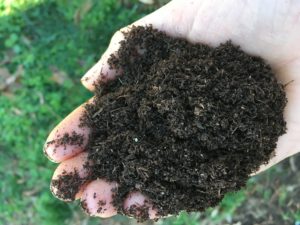Anytime is the Perfect Time to Start Composting!
go.ncsu.edu/readext?445854
en Español / em Português
El inglés es el idioma de control de esta página. En la medida en que haya algún conflicto entre la traducción al inglés y la traducción, el inglés prevalece.
Al hacer clic en el enlace de traducción se activa un servicio de traducción gratuito para convertir la página al español. Al igual que con cualquier traducción por Internet, la conversión no es sensible al contexto y puede que no traduzca el texto en su significado original. NC State Extension no garantiza la exactitud del texto traducido. Por favor, tenga en cuenta que algunas aplicaciones y/o servicios pueden no funcionar como se espera cuando se traducen.
Português
Inglês é o idioma de controle desta página. Na medida que haja algum conflito entre o texto original em Inglês e a tradução, o Inglês prevalece.
Ao clicar no link de tradução, um serviço gratuito de tradução será ativado para converter a página para o Português. Como em qualquer tradução pela internet, a conversão não é sensivel ao contexto e pode não ocorrer a tradução para o significado orginal. O serviço de Extensão da Carolina do Norte (NC State Extension) não garante a exatidão do texto traduzido. Por favor, observe que algumas funções ou serviços podem não funcionar como esperado após a tradução.
English
English is the controlling language of this page. To the extent there is any conflict between the English text and the translation, English controls.
Clicking on the translation link activates a free translation service to convert the page to Spanish. As with any Internet translation, the conversion is not context-sensitive and may not translate the text to its original meaning. NC State Extension does not guarantee the accuracy of the translated text. Please note that some applications and/or services may not function as expected when translated.
Collapse ▲Now is the perfect time to start a compost pile! Trees have shed their leaves, and there are not other lawn chores right now.
Composting is the controlled biological decomposition of organic materials. This creates a beneficial soil amendment called compost. Leaves, food scraps, grass clippings, yard trimmings, and many other organic materials can be composted at home in piles or bins.
Home composting is an easy and economical way to convert organic materials into compost that can be used to enrich soil, enhance plant growth, mulch landscaping plants, and improve soils and plants.
Three Top Reasons to Compost Yard Waste
Saves Money: Converting food scraps and yard trimmings to compost saves on buying soil amendments and fertilizers.
Saves Time: Discarding to a compost pile is often faster than bagging and bundling sticks for street-side yard disposal.
Reduces Community Costs: Your community will need less landfill space, and they will save on equipment, fuel, and labor costs for collecting your organic materials.
Organic materials that can be composted are commonly characterized as “browns” and “greens.” Browns are sugar-rich carbon sources (carbonaceous) that provide energy to microorganisms, absorb excess moisture, and provide structure to your pile. Browns include dead fallen leaves, newspaper, straw, sawdust, napkins, cardboard, twigs, hay, dryer lint, and bark. Greens are protein-rich nitrogen sources (nitrogenous) that provide moisture to microorganisms. Greens include grass clippings, vegetables and fruit, coffee grounds, tea leaves, and livestock manures.
Leaves are the primary organic waste in most backyard compost piles. However, different types of leaves have varying carbon-to-nitrogen (C:N) ratios, which can affect the decomposition rate in your compost pile. For optimal decomposition, the ideal C:N ratio is from 25:1 to 35:1. Maple leaves have a C:N ratio near 30:1, so with the right moisture and frequent turning, maple leaves can break down in several weeks. Oak leaves have a C:N ratio of about 60:1 so they take a lot longer to break down. Mixing oak leaves with high nitrogen materials will accelerate their decomposition.
Set up your compost pile or bin in a convenient location that is more than six feet away from your home or wooden structures. To help it retain moisture, place it in a shaded area within reach of a garden hose. The location should be a flat, open space that is protected from flooding. Keep the areas in front of and above the pile or bin clear so you can work without difficulty.
You can compost as a Single Batch (adding materials all at once to form a pile) or a Continuous Pile (adding materials as they become available). Using the Single Batch (Hot Pile Method), it will take 3 to 6 months to produce finished compost. The Continuous Pile (Cold Pile Method) will take 9 to 12 months longer.
You do not need to use a bin to compost. Some choose to use a bin to keep the pile neat, but it is not necessary. Many people make their own compost bins using concrete blocks, wooden pallets, wire mesh, 55-gallon drums, or garbage cans. There are a variety of manufactured composting bins available, including enclosed, spherical, or tumbler styles.
Garden and field crops, lawns, shrubs, trees, and potted plants can benefit from compost. In our clay soils, compost improves aeration and drainage. Compost makes the soil easier to work. Compost improves water and nutrient holding capacity of the soil. Compost encourages healthy plant roots and may suppress some plant diseases and pests.
Learn more about composting household food scraps and yard waste with our factsheet called “Backyard Composting of Yard, Garden, and Food Discards” available on the N.C. Cooperative Extension website (//caldwell.ces.ncsu.edu) or contact us at the Caldwell Extension Center 828-757-1290 for a printed copy.





